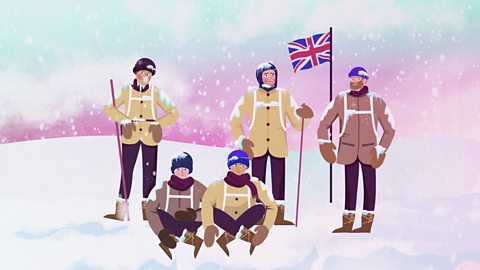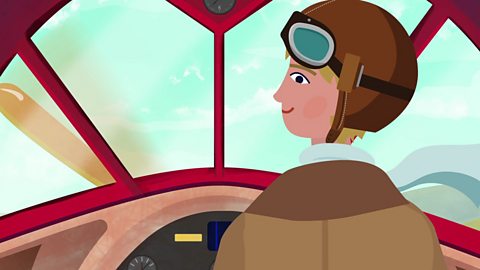FATIMA: Which explorer shall we talk to today, Ollie?
OLLIE: What about someone who has been to the final frontier, Fatima?
FATIMA: Where’s the final frontier?
OLLIE: Space.
FATIMA: Oh yeah. Let’s talk to somebody who’s been to the Moon!
OLLIE: Great idea. Holo-Lab, find the first person to set foot on the Moon.
HOLO-LAB: Searching, Searching… Found. First person to set foot on the Moon: Neil Armstrong.
FATIMA: The Holo-Lab is going back in time, before mobile phones.
OLLIE: Before the internet?
NEIL ARMSTRONG: Hi, I’m Neil Armstrong. In 1969, I was the first person on the Moon.
FATIMA: Hi Neil, we’re Fatima and Ollie and we want to ask you a few questions about the Moon landings.
NEIL ARMSTRONG: Okay, sure. Nice to meet you guys. Shoot.
OLLIE: How did you get to the Moon, Neil?
NEIL ARMSTRONG: I got to the Moon as part of the Apollo 11 mission, aboard the Saturn V rocket.
OLLIE: Why did you go to the Moon?
NEIL ARMSTRONG: Because no one had been there before and we wanted America to be the first country to do so. The President asked NASA to design and build a rocket to take us to the Moon.
FATIMA: How did you get ready to go to the Moon?
NEIL ARMSTRONG: I and the other two astronauts spent months training. We had to understand how to fly the rocket and land the lunar module, and how to get home again.
FATIMA: Was training hard work?
NEIL ARMSTRONG: It was really hard work. It was great fun too. It was a real adventure into the unknown. No one had ever been to the Moon before. NASA had to develop most of the technology we needed for this trip from scratch.
OLLIE: Was it scary?
NEIL ARMSTRONG: Between me and you, it was scary. Sitting in the huge rocket, waiting for take-off, I was super excited and super scared. We were sitting on nearly a million litres of rocket fuel, which could explode at any moment if something went wrong. But I tried to be brave – this was it. The moment we’d been training so hard for.
NASA: Three, two, one… Zero… Lift-off.
FATIMA: Wow! Look at that!
NEIL ARMSTRONG: The Earth is moving around the Sun at 70,000 miles per hour and the Moon is orbiting the Earth at 2,288 miles per hour. The maths that allowed us to calculate the route to the Moon was so complicated that NASA had to get some of the best mathematicians in the world to figure it out. Like Katherine Johnson. She was very, very clever and got us there safely. If she’d made a single mistake in the calculations, we might not have come home at all. Our lives were in her hands.
NEIL ARMSTRONG: One small step for man. One giant leap for mankind.
FATIMA: How did you know what to say?
NEIL ARMSTRONG: We knew it was going to be a big moment and that the whole world would be watching, so we thought really hard about it.
OLLIE: How come you’re so bouncy?
NEIL ARMSTRONG: When you’re on the Moon, gravity is just one sixth of what it is on Earth so on the Moon, I only weighed about fifteen kilograms.
FATIMA: What did it feel like being on the Moon?
NEIL ARMSTRONG: When I was on the Moon, I looked back at the Earth where everyone I knew and loved lived, and it looked so small, like a beautiful marble.
FATIMA: Wow!
OLLIE: Thank you very much for answering all our questions, Neil Armstrong.
NEIL ARMSTRONG: Thanks guys. Maybe one day, one of you will go to Mars. Whatever you do, good luck!
FATIMA: Mars! That would be so cool. Thanks, Neil.
Video summary
Neil Armstrong's historic voyage to the Moon is explored in this short animated film for primary pupils.
This could be used as a starting point for learning about the Earth and space.
For example, learning how the Moon moves in relation to the Earth, or how gravity is different on the Moon compared to the Earth.
This short film is from the BBC series, Explorers.
Teacher Notes
This short film about Neil Armstrong's journey to the Moon could be used as a starting point for learning about the Earth and space.
It describes how the Moon moves in relation to the Earth, and how gravity is different on the Moon compared to the Earth.
The film could also be used as a stimulus for a cross-curricular topic about the Earth and space or Neil Armstrong himself, including the history of space travel or exploration in general.
In the film, Ollie and Fatima learn about the amazing mathematicians who calculated the route the rocket would take to the Moon. This could inspire work in maths around speed, distance and measurements.
In PE, the class could develop their own training plan to build up their fitness ready for a trip to the Moon.
In design and technology, pupils could design and build moon buggies using wood, including axles and cams to make a space explorer move up and down as the moon buggy is pushed forwards.
ICT could then be used to create stop-motion animations of the buggies as they move across the Moon.
This short film also contains a number of great starting points for writing:
Your pupils could prepare their own 'first words' for a momentous occasion. They could write imaginary recounts of their own journey into space, describing their feelings, or using descriptive language to describe what they see in space ("the Earth looked like a marble").
Or they could write in character as Neil Armstrong himself, using his words in this film as a starting point. Neil Armstrong is also a perfect subject for work on biographies and autobiographies.
You could also incorporate learning in art and music into a cross-curricular topic:
You could investigate the rocket paintings of Peter Thorpe and use them as a stimulus for art work.
The class could listen to some of Holst's Planets suite and then compose their own music using percussion or tuned instruments, to portray the 'personality' of the Moon or one of the planets.
This short film could be used to study a variety of cross-curricular topics at KS2 in England and Northern Ireland, Progression Step 3 in Wales and 2nd Level in Scotland. Including;
- Science
- PE
- English
- History
- Design and technology
- ICT
- Art
- Music
- Maths
More from Explorers
Christopher Columbus. video
This short animated film for primary pupils takes a look at Christopher Columbus' epic adventures to the Americas and the changes in travel and exploration over time.

Robert Falcon Scott. video
Robert Falcon Scott's ill-fated journey to the South Pole is brought to life in this short animated film for primary pupils.

Amelia Earhart. video
The life of Amelia Earhart, a courageous pilot who broke records in the air, is introduced to primary pupils in this short animated film.

Ibn Battuta. video
Through Ibn Battuta's epic 29-year journey, primary pupils can explore core learning topics such as creative writing, pilgrimage, Hajj and early Islamic civilisation.
